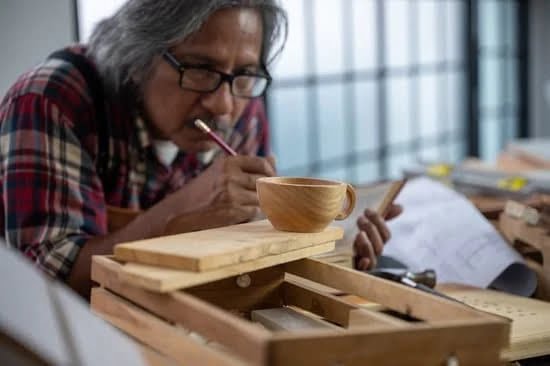Are you interested in learning how to make a Celtic knot woodworking? This traditional craft has deep historical and cultural significance, making it a cherished art form. In this article, we will explore the history and significance of Celtic knots in woodworking, as well as provide you with a step-by-step guide on creating your own masterpiece.
Celtic knots are known for their intricate and interwoven designs, symbolizing eternity, loyalty, faith, and love. The use of these knots in woodworking dates back centuries and continues to be a popular technique among artisans and hobbyists alike. Whether you are a seasoned woodworker or just starting out, creating a Celtic knot woodworking piece can be a rewarding and enjoyable experience.
In the following sections, we will cover the essential tools and materials needed for making a Celtic knot woodworking, as well as detailed instructions on carving and shaping the wood to form the knot. Additionally, we’ll provide tips and tricks for ensuring accuracy and precision in the woodworking process, finishing touches such as sanding, staining, and sealing your masterpiece, displaying and caring for your completed work. Join us on this journey to discover the art of Celtic knot woodworking.
History and Significance of Celtic Knots in Woodworking
Celtic knots have a rich history and deep significance in woodworking, dating back to the Celtic culture of the early medieval period. These intricate designs have been used in various forms of artistic expression, including jewelry, metalwork, and of course, woodworking. The use of Celtic knots in woodworking is not only a display of craftsmanship but also carries symbolic meaning related to eternity, interconnectedness, and the cycle of life.
Symbolism in Celtic Knots
Celtic knots are characterized by their unbroken lines and looping patterns, symbolizing the eternal interconnectedness and continuity of life. The intricate and complex nature of these designs reflects the complexity of life itself. In woodworking, creating a Celtic knot can be a deeply meaningful process as it involves not only the physical act of shaping wood but also an understanding and appreciation for its deeper symbolism.
Historical Significance
The origins of Celtic knots can be traced back to around 450 AD during the Insular art period when they were prominent in manuscripts such as the Book of Kells. As Christianity spread through the Celtic regions, these intricate designs were incorporated into religious artwork as a symbol of faith. In woodworking, these knots were often featured on furniture pieces, architectural elements, and even musical instruments as a way to honor tradition and heritage.
Cultural Impact
The use of Celtic knots in woodworking continues to hold cultural significance for those with Celtic heritage or an appreciation for its symbolism. Many woodworkers take great pride in creating these designs as a way to pay homage to the ancient traditions while also showcasing their woodworking skills.
Whether it’s carving a decorative panel or incorporating the knot pattern into a larger piece of furniture, the presence of Celtic knots adds an element of depth and meaning to the finished woodworking masterpiece.
Essential Tools and Materials Needed for Making a Celtic Knot Woodworking
Creating a stunning Celtic knot woodworking piece requires the use of a few essential tools and materials to help bring your vision to life. Whether you’re a beginner or an experienced woodworker, having the right equipment is crucial in ensuring that the process goes smoothly and that the end product turns out as intended.
When it comes to tools, you’ll need a set of sharp chisels in various sizes to carve intricate details into the wood. A coping saw will also be necessary for cutting out the basic shape of the knot, while a mallet can assist in driving the chisel through the wood with precision. In addition, clamps are vital for securing the wood in place during carving, and a carving knife can be handy for refining small details.
In terms of materials, selecting high-quality hardwood such as oak, cherry, or maple is key to achieving a beautiful finish. Additionally, sandpaper of varying grits will be needed for smoothing out rough edges and surfaces.
Finally, investing in a good quality wood stain and finish will enhance the natural beauty of the wood and protect it from wear and tear over time. By ensuring that you have these essential tools and materials on hand, you’ll be well-equipped to create your own stunning Celtic knot woodworking piece.
Step-by-Step Guide on Creating the Base Design for the Celtic Knot
Creating a beautiful Celtic knot woodworking piece requires precision and patience. The intricate designs have been used for centuries to adorn wooden objects such as furniture, decorations, and jewelry. Before starting your project, it’s important to gather all the necessary tools and materials. This will ensure that you have everything you need to create your masterpiece.
To make a Celtic knot woodworking, there are a few essential tools and materials that you will need. These include wood carving knives, chisels, sandpaper, a carving mallet, wood stain or finish, and of course, a sturdy piece of wood. The type of wood you choose will impact the final look of your creation – softer woods like pine are easier to carve but may not hold as much detail as harder woods like oak or maple.
The first step in making a Celtic knot woodworking is creating the base design for the knot. This involves drawing out the pattern on the wood and carefully planning where each line will go. Start by measuring and marking the center of your wood piece to ensure symmetry in your design.
Once the center is located, use a pencil to lightly draw out the basic structure of your Celtic knot. Keep in mind that this base design will provide the foundation for the rest of your woodworking process.
Detailed Instructions on Carving and Shaping the Wood to Form the Knot
Carving and shaping the wood to form a Celtic knot design requires patience, precision, and skill. Follow these step-by-step instructions to create a stunning Celtic knot woodworking masterpiece:
- Select your preferred type of wood for carving, such as oak, mahogany, or cherry, and ensure it is free from any defects or imperfections.
- Draw the initial design of your Celtic knot on the wood using a pencil or chalk. Start with a simple pattern if you are new to woodworking, and gradually progress to more intricate designs as you gain experience.
- Use a sharp wood carving knife or chisel to carefully carve along the lines of your drawn design, removing small pieces of wood at a time. Take your time and work slowly to avoid mistakes or accidents.
- As you continue carving, pay close attention to the depth and angle of each cut to create dimension within the knot design. Be mindful of symmetry and balance in the overall pattern.
- Once you have completed carving the basic outline of your Celtic knot, use finer carving tools to add detail and texture to the wood. This will enhance the intricacy and beauty of the finished piece.
- After shaping the knot’s details, carefully sand down any rough edges or uneven surfaces with fine-grit sandpaper to achieve a smooth finish.
Remember that mastering this technique takes practice, so don’t be discouraged if your first attempts are not perfect. With time and dedication, you can create beautiful Celtic knot woodworking pieces that showcase your skills and passion for this ancient art form.
Tips and Tricks for Ensuring Accuracy and Precision in the Woodworking Process
When creating a Celtic knot woodworking piece, ensuring accuracy and precision in the woodworking process is essential to achieving a visually appealing and structurally sound masterpiece. Here are some tips and tricks that will help you make the most of your woodworking project:
Firstly, it’s important to have a well-thought-out plan before starting the woodworking process. This includes sketching out the design, determining the dimensions, and identifying the specific techniques you will use. Having a clear plan in place will help you stay focused and organized throughout the project.
Another tip for ensuring accuracy in Celtic knot woodworking is to invest in high-quality tools. Sharp chisels, precise carving knives, and reliable clamps are crucial for achieving clean cuts and smooth finishes on your wood pieces. Additionally, using a marking gauge or fine-tipped pencil to measure and mark your cuts will help maintain precision during the shaping process.
Furthermore, paying attention to detail is key when creating intricate Celtic knots in woodworking. Take your time to ensure that each curve, loop, and intersection of the knot is carefully carved and shaped according to your design. Patience and attention to detail are crucial for achieving a flawless result.
By following these tips and tricks, you can elevate your Celtic knot woodworking skills and create stunning pieces that showcase both artistry and craftsmanship.
| Tips for Ensuring Accuracy | Woodworking Process |
|---|---|
| Create a well-thought-out plan before starting | Invest in high-quality tools |
| Precisely measure and mark your cuts | Attention to detail is crucial |
Finishing Touches
After successfully carving and shaping the wood to form your intricate Celtic knot woodworking masterpiece, the next essential step is to give it the finishing touches that will enhance its beauty and durability. This involves sanding, staining, and sealing the wood to achieve a polished and professional look.
Firstly, begin by sanding the entire surface of the Celtic knot woodworking piece using fine-grit sandpaper. This will help smooth out any rough edges or uneven surfaces left from the carving process. Be sure to sand in the direction of the wood grain to avoid creating any scratches or imperfections.
Once the sanding process is complete and you are satisfied with the smoothness of your woodworking piece, it’s time to choose a suitable stain to enhance its natural beauty. Select a high-quality wood stain in a color that complements the type of wood you have used for your Celtic knot design. Apply an even coat of stain using a brush or clean cloth, following the manufacturer’s instructions for drying times between coats if necessary.
Finally, once your stained woodworking piece has dried completely, seal it with a clear varnish or lacquer to protect it from moisture, dust, and other potential damage over time. Apply multiple thin coats of sealant, allowing each coat to dry before applying the next. Once fully sealed, your Celtic knot woodworking masterpiece will be ready for display and enjoyment for years to come.
- Sandpaper
- High-quality wood stain
- Brush or clean cloth
- Clear varnish or lacquer
Remember these key steps when finishing up your masterpieces:
- Start by thoroughly sanding down any rough spots.
- Choose a high quality stain that complements your chosen type of wood.
- Seal with clear varnish or lacquer for added protection.
By following these important steps in finishing your Celtic knot woodworking pieces,, you can ensure that they will stand out as beautifully crafted works of art for all to admire.
Displaying and Caring for Your Completed Celtic Knot Woodworking Masterpiece
Choosing the Right Display Location
Once you have completed your Celtic knot woodworking masterpiece, it’s time to think about where and how you will display it. Consider choosing a location that is not only visible but also free from direct sunlight, extreme temperatures, and high humidity. These environmental factors can damage the wood and the finish over time. Additionally, make sure that the display area is secure and stable to prevent accidental damage or falling.
Caring for Your Celtic Knot Woodworking
To ensure that your Celtic knot woodworking remains in excellent condition for years to come, proper care is essential. Regular dusting with a soft, dry cloth can help maintain its appearance. Avoid using harsh chemicals or abrasive cleaners that can damage the wood or finish. If your masterpiece starts to look dull, consider applying a fresh coat of wax or furniture polish to revive its luster.
Protecting Your Woodworking From Damage
To protect your completed Celtic knot woodworking from scratches, dents, and other physical damage, consider placing it on a soft surface such as felt or fabric pads. This will prevent friction between the wood and any display surfaces. If you need to move or transport your artwork, wrap it carefully in a soft cloth or bubble wrap to prevent any accidental damage during handling.
By following these simple tips for displaying and caring for your completed Celtic knot woodworking masterpiece, you can enjoy its beauty for many years to come while preserving its quality and craftsmanship.
Additional Resources and Inspiration for Advancing Your Celtic Knot Woodworking Skills
In conclusion, the art of Celtic knot woodworking is a beautiful and intricate craft that holds deep historical and cultural significance. The process of creating a Celtic knot woodworking masterpiece involves essential tools and materials, a step-by-step guide on designing the base, detailed instructions for carving the wood, tips for precision, and finishing touches such as sanding, staining, and sealing.
Mastering the art of making a Celtic knot woodworking piece requires dedication, patience, and an eye for detail. However, as with any craft, practice makes perfect. Taking the time to learn and understand the history and significance of Celtic knots in woodworking can provide valuable insight and inspiration to create your own unique designs.
For those looking to continue advancing their skills in Celtic knot woodworking, there are countless resources available to offer guidance and encouragement. Whether it’s through online tutorials, workshops, or connecting with other woodworking enthusiasts, there are many avenues to explore in order to expand your knowledge and expertise in this timeless art form. By continuing to seek out additional resources and inspiration, you can further develop your skills and create even more stunning Celtic knot woodworking pieces.
Frequently Asked Questions
How Do You Make a Celtic Knot?
Making a Celtic knot involves using a series of interwoven lines that form intricate patterns with no beginning or end. It typically starts with a grid of equilateral triangles and then the lines are weaved over and under each other to create the desired design.
Patience and precision are key when making a Celtic knot, as it can be quite intricate and detailed.
How Do I Make a Celtic Heart Knot?
Creating a Celtic heart knot is a beautiful and meaningful craft. It involves shaping the lines into two connected hearts, symbolizing love and connection. The process includes carefully weaving the lines to form the heart shapes, ensuring they are balanced and symmetrical.
What Is the Coolest Celtic Knot?
The coolest Celtic knot is subjective to personal preference, as there are countless designs that vary in complexity and symbolism. Some may find the endless knot to be fascinating due to its representation of interconnectedness and eternity, while others may be drawn to simpler designs such as the triskele or triquetra for their aesthetic appeal.
Ultimately, the coolest Celtic knot is whichever holds the most significance or visual appeal to the individual admiring it.

Hi everyone! I’m a woodworker and blogger, and this is my woodworking blog. In my blog, I share tips and tricks for woodworkers of all skill levels, as well as project ideas that you can try yourself.





